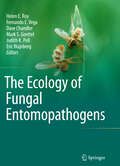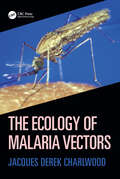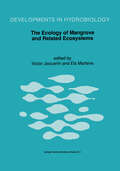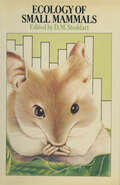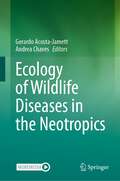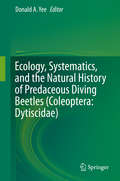- Table View
- List View
Ecology of Fresh Waters: Man and Medium, Past to Future
by Brian R. MossThis established textbook continues to provide a comprehensive and stimulating introduction to rivers, lakes and wetlands, and was written as the basis for a complete course on freshwater ecology. Designed for undergraduate and early postgraduate students who wish to gain an overall view of this vast subject area, this accessible guide to freshwater ecosystems and man's activities will also be invaluable to anyone interested in the integrated management of freshwaters. The author maintains the tradition of clarity and conciseness set by previous editions, and the text is extensively illustrated with photographs and diagrams. Examples are drawn from the author's experience in many parts of the world. In this edition, the scientific content of the text has been fully revised and updated. Emphasis has been placed on human impacts, and a completely new chapter has been added on the future of freshwaters. Balanced and stimulating introduction to limnology. Successfully combines fundamental and applied aspects of integrated management of freshwaters, with strong emphasis on human links. Completely revised and rewritten with a threefold increase in the number of illustrations. New chapter on the future of freshwaters. Of interest to undergraduates, beginning postgraduates and any limnologically interested reader.
Ecology of Fresh Waters: A View for the Twenty-First Century
by Brian R. MossThis new edition of an established textbook provides a comprehensive and stimulating introduction to rivers, lakes and wetlands, and was written as the basis for a complete course on freshwater ecology. Designed for undergraduate and early postgraduate students who wish to gain an overall view of this vast subject area, this accessible guide to freshwater ecosystems and man's activities will also be invaluable to anyone interested in the integrated management of freshwaters. The author maintains the tradition of clarity and conciseness set by previous editions, and the text is extensively illustrated with photographs and diagrams. Examples are drawn from the author's experience in many parts of the world, and the author continues to stress the human influence. The scientific content of the text has been fully revised and updated, making use of the wealth of data available since publication of the last edition. Professor Brian Moss is a lecturer in Applied Ecology at the University of Liverpool, and has written three previous editions of this well-established textbook.
Ecology of Freshwater Nematodes
by Nabil Majdi Janina Schenk Mike Hodda Christoph Ptatscheck Birgit Gansfort Tom Moens Sebastian Höss Hendrik FueserNematodes are incontestably the most numerous and the most diverse metazoans in freshwater habitats, and these properties bestow exceptional significance to their role in the environment. An array of functional roles has been attributed to them: they are grazers on bacteria and primary producers, regulators of decomposition of plant material, predators, prey for other animals, and closely associated symbionts of bacteria and other organisms. Freshwater nematodes are central in the context of environmental monitoring, pollution assessments, global warming and food webs, and this is increasingly being recognized. Moreover, the short generation time (a few days to months) of many species makes nematodes ideal for laboratory studies. This book: Provides a follow-up to Freshwater Nematodes: Ecology and Taxonomy (2006). Offers guidelines for studying the ecology of free-living nematodes, including detailed protocols and case studies. Promotes free-living nematodes as model organisms for studies in a broad range of research fields. Despite the recognized importance of nematodes across ecosystems, many species of free-living nematodes have yet to be discovered, and essential knowledge gaps remain. Ecology of Freshwater Nematodes provides an overview of research efforts in this field, and is an important resource for researchers in the field of nematology and ecology.
The Ecology of Fungal Entomopathogens
by Dave Chandler Judith K. Pell Eric Wajnberg Helen E. Roy Fernando E. Vega Mark S. GoettelUnderstanding of the ecology of fungal entomopathogens has vastly increased since the early 1800’s, but remains challenging. The often complex interactions between pathogen and host are being unravelled through eloquent research and the importance of the often subtle interactions, in determining the success or failure of biological control, cannot be underplayed. The realm of ecology is vast and deciphering insect-fungal pathogen interactions within an ecological context will take us on voyages beyond our imagination. This book brings together the work of renowned scientists to provide a synthesis of recent research on the ecology of fungal entomopathogens exploring host-pathogen dynamics from the context of biological control and beyond. Dr. Helen Roy leads zoological research in the Biological Records Centre at the NERC Centre for Ecology & Hydrology, UK. The focus of her research is insect community interactions with particular emphasis on the effects of environmental change. She has been working on the ecological interactions between fungal entomopathogens and their hosts for 15 years; this continues to be a source of fascination. She has been an associate editor of BioControl since 2006. Dr. Dave Chandler is an insect pathologist at the University of Warwick, UK. He has studied entomopathogenic fungi for just over 20 years. He has particular interests in entomopathogenic fungi as biocontrol agents of horticultural crops, fungal physiology and ecology, and the pathogens of honeybees. Dr. Mark Goettel is an insect pathologist at the Lethbridge Research Centre of Agriculture & Agri-Food Canada, specializing in the development of fungal entomopathogens as microbial control agents of insects. In addition to this research, he has been extensively involved in the review and revision of the regulations for registration of microbial control agents and has addressed regulatory and safety issues at the international level. He is currently President of the Society for Invertebrate Pathology and has been Editor-in-Chief of Biocontrol Science & Technology since 2000. Dr. Judith K. Pell heads the Insect Pathology Group in the Department for Plant and Invertebrate Ecology at Rothamsted Research, UK. She leads research on the ecology of fungal entomopathogens, to elucidate their role in population regulation and community structure and to inform biological control strategies. Specifically: intraguild interactions; the relationships between guild diversity, habitat diversity and ecosystem function; pathogen-induced host behavioural change. Dr. Eric Wajnberg is a population biologist specialising in behavioural ecology, statistical modelling and population genetics. He is also an expert in biological control, with more than 20 years experience of working with insect parasitoids. He has been the Editor in Chief of BioControl since 2006. Dr. Fernando E. Vega is an entomologist with the United States Department of Agriculture, Agricultural Research Service, in Beltsville, Maryland, USA. He conducts research on biological methods to control the coffee berry borer, the most important insect pest of coffee throughout the world. He is co-editor, with Meredith Blackwell, of Insect-Fungal Associations: Ecology and Evolution, published by Oxford University Press in 2005, and serves as an Editorial Board Member for Fungal Ecology.
Ecology of Invertebrate Diseases
by Ann E. Hajek David I. Shapiro-IlanA rapidly growing interdisciplinary field, disease ecology merges key ideas from ecology, medicine, genetics, immunology, and epidemiology to study how hosts and pathogens interact in populations, communities, and entire ecosystems. Bringing together contributions from leading international experts on the ecology of diseases among invertebrate species, this book provides a comprehensive assessment of the current state of the field. Beginning with an introductory overview of general principles and methodologies, the book continues with in-depth discussions of a range of critical issues concerning invertebrate disease epidemiology, molecular biology, vectors, and pathogens. Topics covered in detail include: Methods for studying the ecology of invertebrate diseases and pathogens Invertebrate pathogen ecology and the ecology of pathogen groups Applied ecology of invertebrate pathogens Leveraging the ecology of invertebrate pathogens in microbial control Prevention and management of infectious diseases of aquatic invertebrates Ecology of Invertebrate Diseases is a necessary and long overdue addition to the world literature on this vitally important subject. This volume belongs on the reference shelves of all those involved in the environmental sciences, genetics, microbiology, marine biology, immunology, epidemiology, fisheries and wildlife science, and related disciplines.
Ecology of Invertebrate Diseases
by Ann E. Hajek David I. Shapiro-IlanA rapidly growing interdisciplinary field, disease ecology merges key ideas from ecology, medicine, genetics, immunology, and epidemiology to study how hosts and pathogens interact in populations, communities, and entire ecosystems. Bringing together contributions from leading international experts on the ecology of diseases among invertebrate species, this book provides a comprehensive assessment of the current state of the field. Beginning with an introductory overview of general principles and methodologies, the book continues with in-depth discussions of a range of critical issues concerning invertebrate disease epidemiology, molecular biology, vectors, and pathogens. Topics covered in detail include: Methods for studying the ecology of invertebrate diseases and pathogens Invertebrate pathogen ecology and the ecology of pathogen groups Applied ecology of invertebrate pathogens Leveraging the ecology of invertebrate pathogens in microbial control Prevention and management of infectious diseases of aquatic invertebrates Ecology of Invertebrate Diseases is a necessary and long overdue addition to the world literature on this vitally important subject. This volume belongs on the reference shelves of all those involved in the environmental sciences, genetics, microbiology, marine biology, immunology, epidemiology, fisheries and wildlife science, and related disciplines.
The Ecology of Malaria Vectors
by Jacques Derek CharlwoodThis practical book covers all aspects of the biology of malaria vectors, with notes on the vectors of dengue. It is the first work in this field to concentrate on mosquitoes, rather than covering all disease vectors. Authored by renowned field entomologist Jacques Derek Charlwood, it disseminates his vast experience working on mosquito biology, ecology and the evaluation of new vector control tools across five continents over the past 40 years. Covering all aspects from classification and systematics, population dynamics, vector control, to surveillance and sampling, epidemics, and a selection of case histories, the book also considers genetics and resistance, Aedes biology, and malaria and dengue models. It is designed to fill the gap between very specialized texts and undergraduate books on general disease vectors, and is ideal as a textbook for postgraduate courses in entomology and mosquito vectors of disease.
The Ecology of Malaria Vectors
by Jacques Derek CharlwoodThis practical book covers all aspects of the biology of malaria vectors, with notes on the vectors of dengue. It is the first work in this field to concentrate on mosquitoes, rather than covering all disease vectors. Authored by renowned field entomologist Jacques Derek Charlwood, it disseminates his vast experience working on mosquito biology, ecology and the evaluation of new vector control tools across five continents over the past 40 years. Covering all aspects from classification and systematics, population dynamics, vector control, to surveillance and sampling, epidemics, and a selection of case histories, the book also considers genetics and resistance, Aedes biology, and malaria and dengue models. It is designed to fill the gap between very specialized texts and undergraduate books on general disease vectors, and is ideal as a textbook for postgraduate courses in entomology and mosquito vectors of disease.
The Ecology of Mangrove and Related Ecosystems: Proceedings of the International Symposium held at Mombasa, Kenya, 24–30 September 1990 (Developments in Hydrobiology #80)
by Victor Jaccarini Els MartensThe mangrove, seagrass and coral reef ecosystems are of paramount ecological importance but have already undergone great degradation, which is advancing at an alarming rate. If present trends continue, the natural resource basis of the economy and ecology of tropical coastal regions will soon be ruined. This was the unanimous conclusion of the 110 scientists from 23 countries who gathered in Mombasa, Kenya, for a Symposium on the ecology of these ecosystems. Mangrove forest systems yield large amounts of fish, crabs, prawns and oysters. They are also valuable sources of fuelwood, timber, tannin and other natural products. Their non-marketable value is of equal importance: stabilization of the coastline, an indispensable nursery ground for numerous marine species with commercial value, a natural filter maintaining the clarity of nearshore water, a home for resident and migratory birds and other wildlife. Many of the true mangrove flora and fauna are now endangered by the clearing of the mangroves. It has been shown that in many countries between 25 and 100% of the mangrove forest has been destroyed alraedy in the last twenty years. The international scientific assembly concluded that much can be done to stop the degradation of these damaged ecosystems and to rehabilitate them. But new techniques must be found to use them on a sustainable basis for long-term economic return and for the well-being of coastal human settlements and a healthy environment.
Ecology of Marine Bivalves: An Ecosystem Approach, Second Edition
by Richard F. DameExploring the potential use of bivalves as indicators and monitors of ecosystem health, this book describes live and computer simulated experiments, mesocosm studies, and field manipulation experiments. This second edition discusses major new developments, including phase shifts in many coastal and estuarine ecosystems dominated by suspension-feeding bivalves, the invasion or introduction of alien bivalve species, the rapid growth of environmental restoration focused on bivalves, and the examination of geological history with regard to global climate change and its impact on bivalve-dominated systems.
Ecology of Marine Bivalves: An Ecosystem Approach, Second Edition
by Richard F. DameExploring the potential use of bivalves as indicators and monitors of ecosystem health, this book describes live and computer simulated experiments, mesocosm studies, and field manipulation experiments. This second edition discusses major new developments, including phase shifts in many coastal and estuarine ecosystems dominated by suspension-feeding bivalves, the invasion or introduction of alien bivalve species, the rapid growth of environmental restoration focused on bivalves, and the examination of geological history with regard to global climate change and its impact on bivalve-dominated systems.
Ecology of Marine Deposit Feeders (Coastal and Estuarine Studies #31)
by Glenn Lopez Gary Taghon Jeffrey LevintonDeposit feeders, animals that derive nutrition from organic matter in sedimentary deposits, are dominant among the inhabitants of muds and, therefore, of the benthos of much of the ocean. In this volume the critical research problems pertaining to deposit feeders are identified and promising approaches for dealing with those problems are proposed. Interdisciplinary approaches are of utmost importance in the study of deposit feeders and their sedimentary environment, merging fields as disparate as nutritional physiology and sediment geochemistry. Among the topics presented are advances in theories of foraging and digestion, and new experimental approaches to study the potential foods, feeding behavior and physiology of animals that ingest sediment.
The Ecology of Mycobacteria: Impact On Animal's And Human's Health
by Jindrich Kazda Ivo Pavlik Joseph O. Falkinham III Karel Hruskahabitats and the overlapping of these biotopes by humans and animals contributed to the spread of mycobacteria and perhaps to their convergence to pathogenicity. It was not our intention to present a compendium covering all published results, but rather to issue a “readable” book, which is illustrative and thus focused on the principle facts. The increase in the number of Editors has allowed the sharing of original experiences regarding the ecology of mycobacteria, published here for the ?rst time in some cases. The supplemented edition should serve as a guide to these discoveries and also contribute to an understanding of clinically signi?cant species in human and animal medicine. Borstel, Germany, January 2009 Jindrich Kazda Editors’Comments The editors responsible for the chapters are listed under the title of each chapter. Authors are listed under the titles of subchapters. The references are listed as they appear in the databases Reference Manager (Thomson Reuters, Philadelphia) as imported from Web of Science (Thomson Reuters, Philadelphia) or PubMed (Medline, NLM Bethesda). A few citations, not indexed, were cited according to the reprints or books available. This principle resulted in minor differences in the titles (not all reference titles are in English, some references have capitalized title words, not all species names are according to the contemporary nomenclature and in italics). Some journals are cited with abbreviated titles, some in full, as available in the source databases. These differences were left in the format of the database.
The Ecology of Reproduction in Wild and Domestic Mammals
by R.M. Sadler49 about six months ... to well over a year. If there is only one part of the year that is favourable, such as spring and early summer in the temperate climates, then each species must make an evolutionary choice, so to speak, as to which parts of the reproductive cycle - conception, gestation, lactation or weanin- must be protected and which can come in less favourable times of the year. The rhesus and langur monkeys of northern India give birth during the time of year when temperatures are hottest and wells and tanks are often dry. However, gestation and the later months oflactation come during the monsoon season when food and water are abundant. In contrast the east African baboons give birth at the beginning of the small rains, and gestation and the late part of lactation occur during the six months dry season. Whether any pattern of relationship will be found to hold true for other species of primates is still not clear. It may be that a wide variety of patterns have evolved depending on the lengths of gestation and lactation and the particular ecological complex in which each species or even subspecies lives' (pages 503, 504).
Ecology of Sensing
by Friedrich G. Barth Axel SchmidSense organs serve as a kind of biological interface between the environment and the organism. Therefore, the relationship between sensory systems and ecology is very close and its knowledge of fundamental importance for an understanding of animal behavior. The sixteen chapters of this book exemplify the diversity of the constraints and opportunities associated with the sensation of stimuli representing different forms of energy. The book stresses the events taking place in the sensory periphery where the animal is exposed to and gets in touch with its natural habitat and acquires the information needed to organize its interaction with its environment. Ecology of Sensing brings together the leading experts in the field.
Ecology of small mammals
by D. M. StoddartFrom their largely descriptive beginnings about a half century ago, studies on the ecology of small mammals have mushroomed in number, scope, content and complexity. Yet strangely, or perhaps not so strangely if one considers the extent and complexity of ecological interactions, the main problems for which the early workers sought answers still defy complete analysis, and basic hypotheses remain untested if not even untestable. The same holds true for so many branches of animal ecology that it seems to be the complexity of the concepts that frustrates efforts rather than the subject species. Like all branches of science, small mammal ecology has been subject to a series of fashionable approaches, one following another as tech nology penetrates previously impregnable regions. Doubtless the future development of our science will be punctuated by wave upon wave of new endeavour in whole fields that are perhaps even yet unidentified. Answers to the complex questions which ecologists ask do not come easily. Increasingly though, they arise in direct proportion to the efforts expended upon their elucidation. Many studies have achieved such a high level of elegance, in terms of manpower and apparatus, that there is a feeling that questions asked when such resources are unavailable are not worth asking. Nothing could be further from the truth. Many a complex model has failed fully to explain the phenomenon for which it was construc ted because of a lack of basic field data on the species' natural h~story.
The Ecology of Social Behavior
by C. N. SlobodchikoffThe Ecology of Social Behavior explores the relationships between ecology and the origins and maintenance of social behavior. The chapters in this book suggest that a consideration of ecological factors is necessary to any paradigm that tries to explain the origins and maintenance of social behavior. Most also suggest that there are some trade-offs between ecology, genetics, and phylogeny in the development and persistence of specific social systems. The book is organized into five parts. Part I provides an overview of the main themes covered in the present volume. Part II contains papers on ecological interactions, including variation in group sizes of forest primates, group foraging, and the origin of monogamy in mammals and fishes. Part III examines the ecology of social mammals. These include the ecological conditions for philopatry and the relationship of habitat variability to sociality in yellow-bellied marmots. Part IV focuses on the ecology of social birds while Part V deals with the ecology of social arthropods.
Ecology of Social Evolution
by Judith Korb Juergen HeinzeThe time is ripe to investigate similarities and differences in the course of social evolution in different animals. This book brings together renowned researchers working on sociality in different animals to deal with the key questions of sociobiology. For the first time, they compile the evidence for the importance of ecological factors in the evolution of social life, ranging from invertebrate to vertebrate social systems, and evaluate its importance versus that of relatedness.
Ecology of Ungulates: A Handbook of Species in Eastern Europe and Northern and Central Asia
by Leonid Baskin Kjell DanellThe knowledge on the ecology of ungulates (orders Perissodactyla and Artiodactyla) inhabiting eastern Europe and northern and central Asia is of special importance for those interested in zoology, ecology, nature conservation, hunting and management. There are 26 species of ungulates 2 oE-169°W within the 22. 4 million km area, between 35-82°N and 20 and they occupy several vegetation zones from arctic deserts to the subtropics. In our opinion, the advancement of science can be retarded and general conclusions will be difficult to make, if the knowledge of the organisms inhabiting one sixth of the world'sland surface, covered by this vast region, is not included. The language barrier, as well as the lack of international accessibility of local publications, makes it difficult to make use of the great volume of scientific information gathered within the territory of the former USSR. The only complete ecological review of ungulates of the Soviet Union, Mammals of the Soviet Union, vol. 1. Ungulates, was published by V. G. Heptner, A. A. Nasimovich, and A. G. Bannikov in 1961 (in Russian, Heptner and Naumov 1961)and 1989(the English translation,Heptner and Naumov 1989). This excellent book does not, however, contain scientific contributions published after 1959. This is unfortunate, because during the foHowing40years,intense and highly qualified research on the ecology and behavior of ungulates was performed.
Ecology of Urban Environments
by Kirsten M. ParrisProvides an accessible introduction to urban ecology, using established ecological theory to identify generalities in the complexity of urban environments. Examines the bio-physical processes of urbanization and how these influence the dynamics of urban populations, communities and ecosystems Explores the ecology of humans in cities Discusses practical strategies for conserving biodiversity and maintaining ecosystem services in urban environments Includes case studies with questions to improve retention and understanding
Ecology of Urban Environments
by Kirsten M. ParrisProvides an accessible introduction to urban ecology, using established ecological theory to identify generalities in the complexity of urban environments. Examines the bio-physical processes of urbanization and how these influence the dynamics of urban populations, communities and ecosystems Explores the ecology of humans in cities Discusses practical strategies for conserving biodiversity and maintaining ecosystem services in urban environments Includes case studies with questions to improve retention and understanding
Ecology of Wild Bird Diseases
by Sasan FereidouniThe book focuses on the ecology of the most important infectious diseases of wild avian hosts, especially those with high morbidity and mortality rates. Disease ecology is an important scientific approach to study the relationships and interactions between living organisms, their environment, and potential pathogens. Birds have high diversity, and the very special ability to fly and migrate. They migrate over long distances, and share ecosystems with other animals, even humans. They serve as the most important natural source of several pathogens with zoonotic potential. Bird-pathogen interactions are increasingly changing due to the continuous anthropogenic disturbances in habitats and ecosystems. With intensified climate change and improved environmental conditions for vectors, as well as higher susceptibility of avian hosts due to simultaneous exposure to environmental stressors (e.g., contamination, food limitation, etc.), the probability of emerging new infections and their expansion into new territories increase tremendously. The Covid-19 pandemic has shown that neglected ecological and epidemiological interactions between wildlife, domestic animals and humans are paramount to global health.The book has a different approach to understanding complex and multiscale interactions among various ecological factors for the most important infectious diseases of wild birds. It provides valuable data to students and everyone who deals with avian species including biologists, researchers, conservationists, and policymakers.
Ecology of Wild Bird Diseases
by Sasan FereidouniThe book focuses on the ecology of the most important infectious diseases of wild avian hosts, especially those with high morbidity and mortality rates. Disease ecology is an important scientific approach to study the relationships and interactions between living organisms, their environment, and potential pathogens. Birds have high diversity, and the very special ability to fly and migrate. They migrate over long distances, and share ecosystems with other animals, even humans. They serve as the most important natural source of several pathogens with zoonotic potential. Bird-pathogen interactions are increasingly changing due to the continuous anthropogenic disturbances in habitats and ecosystems. With intensified climate change and improved environmental conditions for vectors, as well as higher susceptibility of avian hosts due to simultaneous exposure to environmental stressors (e.g., contamination, food limitation, etc.), the probability of emerging new infections and their expansion into new territories increase tremendously. The Covid-19 pandemic has shown that neglected ecological and epidemiological interactions between wildlife, domestic animals and humans are paramount to global health.The book has a different approach to understanding complex and multiscale interactions among various ecological factors for the most important infectious diseases of wild birds. It provides valuable data to students and everyone who deals with avian species including biologists, researchers, conservationists, and policymakers.
Ecology of Wildlife Diseases in the Neotropics
by Gerardo Acosta-Jamett Andrea ChavesThis contributed volume focuses on the Neotropical region, and explores the environmental, ecological and socio-economic components that facilitate the emergence of zoonotic diseases. This book highlights the primary ecological, environmental, social, and economic variables associated with the risk of maintenance, transmission, and dissemination of emerging, re-emerging, and neglected infectious diseases, in which Neotropical vertebrates are involved. It compiles up-to-date knowledge and research for the neotropical region, as well as discusses the current needs of knowledge improvement. The chapters include various examples of the cycles of infectious diseases, all with world-wide relevance where neotropical wild vertebrates are affected or involved.
Ecology, Systematics, and the Natural History of Predaceous Diving Beetles (Coleoptera: Dytiscidae)
by Donald A. YeePredaceous diving beetles (Coleoptera: Dytiscidae) constitute one of the largest families of freshwater insects (~ 4,200 species). Although dytiscid adults and larvae are ubiquitous throughout a variety of aquatic habitats and are significant predators on other aquatic invertebrates and vertebrates, there are no compilations that have focused on summarizing the knowledge of their ecology, systematics, and biology. Such knowledge would benefit anyone working in aquatic systems where dytiscids are an important part of the food web. Moreover, this work will allow a greater appreciation of dytiscids as model organisms for investigations of fundamental principles derived from ecological and evolutionary theory. Contributed chapters are by authors who are actively engaged in studying dytiscids and each chapter offers a synthesis of the current knowledge of a variety of topics and will provide future directions for research.



